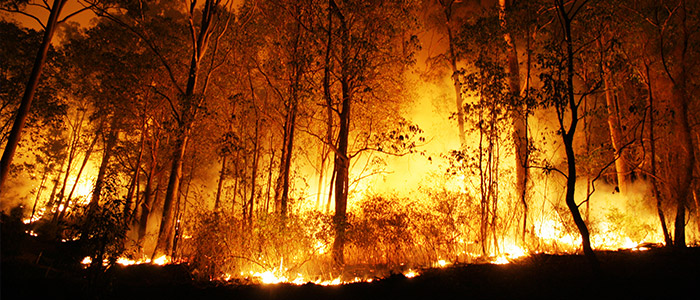Fire in the Forest

Vegetation fires can occur naturally, due to lightning strikes, but fire is often used deliberately in tropical regions to clear land where it is being used for plantations, such as oil palm or timber. Vegetation and peatlands may also be increasingly susceptible to fire under a warming climate and likely to burn over larger areas, with increased episodes of hotter and drier conditions.
Researchers from LEAF have been studying the relationship between forest loss and the occurance of fires. In Indonesia, Adrianto et al., (2019) found that, between 2001 and 2012, regions that experienced forest loss had six times more fires than those with forest cover retained. Protected areas and restoration have some potential to help reduce the risk of fires.
When forests or grasslands burn, the fire releases greenhouse gases (e.g., carbon dioxide) and particles (e.g., black carbon) into the atmosphere. The air above rainforests is generally very clean, so these fires contribute substantially to the composition of the atmosphere and can have a significant impact on regional climate and local air quality.
Different kinds of vegetation fire emit different gases and particles, in varying amounts, when they burn. Aerosols released from vegetation fires can cause a cooling of the planet, as they reflect sunlight back into space and can brighten clouds. However, the release of carbon dioxide in forest fires, and the impact of fires on the capacity of remaining forests to sequester and store carbon, can have a warming effect. Understanding these processes is important for determining the impact of fires on the climate.
In addition to fires directly impacting wildlife and habitats, the particulate matter emitted from burning vegetation and peat can significantly degrade air quality, bringing a health burden to local and regional populations. Researchers in LEAF have been studying the link between vegetation fires and health in Indonesia. In recent years, large fire events in the region have emitted huge quantities of particulate matter into the atmosphere. This is of concern as the particulate matter can enter people’s lungs and bloodstream and bring respiratory and heart problems. Kiely et al., (2020) estimate that vegetation and peat fires in equatorial Asia caused more than 100,000 premature deaths between the years 2004 and 2015.
Reducing deforestation, such as with protected areas, could help to reduce the occurrence of fires, build forest resilience and improve air quality.
Check out our news page for new research on this theme.
